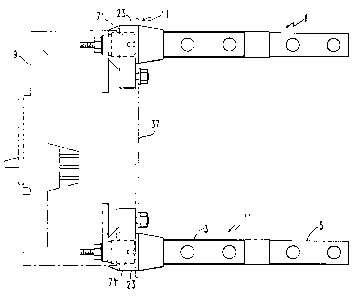Une partie des informations de ce site Web a été fournie par des sources externes. Le gouvernement du Canada n'assume aucune responsabilité concernant la précision, l'actualité ou la fiabilité des informations fournies par les sources externes. Les utilisateurs qui désirent employer cette information devraient consulter directement la source des informations. Le contenu fourni par les sources externes n'est pas assujetti aux exigences sur les langues officielles, la protection des renseignements personnels et l'accessibilité.
L'apparition de différences dans le texte et l'image des Revendications et de l'Abrégé dépend du moment auquel le document est publié. Les textes des Revendications et de l'Abrégé sont affichés :
| (12) Brevet: | (11) CA 2154973 |
|---|---|
| (54) Titre français: | DISPOSITIF POUR ASSUJETTIR EN ALTERNANCE LES BARRES OMNIBUS AUX INTERRUPTEURS |
| (54) Titre anglais: | APPARATUS FOR SECURING BUS BARS TO SWITCHES IN ALTERNATIVE POSITIONS |
| Statut: | Périmé et au-delà du délai pour l’annulation |
| (51) Classification internationale des brevets (CIB): |
|
|---|---|
| (72) Inventeurs : |
|
| (73) Titulaires : |
|
| (71) Demandeurs : |
|
| (74) Agent: | SMART & BIGGAR LP |
| (74) Co-agent: | |
| (45) Délivré: | 2003-01-21 |
| (22) Date de dépôt: | 1995-07-28 |
| (41) Mise à la disponibilité du public: | 1996-01-30 |
| Requête d'examen: | 1998-10-20 |
| Licence disponible: | S.O. |
| Cédé au domaine public: | S.O. |
| (25) Langue des documents déposés: | Anglais |
| Traité de coopération en matière de brevets (PCT): | Non |
|---|
| (30) Données de priorité de la demande: | ||||||
|---|---|---|---|---|---|---|
|
Des barres omnibus rectangulaires engagées de façon alternée dans l'une ou l'autre parmi une paire de fentes croisées dans un bloc de support fixé dans un tableau de contrôle sont verrouillées en place par un dispositif de verrouillage incorporé dans une partie borne cylindrique de chaque barre omnibus. Le dispositif de verrouillage comprend une bague extensible logée dans une rainure circonférentielle dans la partie borne cylindrique. Deux goupilles d'actionnement sont poussées radialement vers l'extérieur dans des alésages diamétralement opposés pour caler la bague extensible contre le bloc de support, par une vis tronconique vissée dans un alésage longitudinal central dans la partie borne de la barre omnibus.
Rectangular bus bars alternatively engaged in either of a pair of crossed slots in a support block secured in a panel board are locked in place by a locking device incorporated in a cylindrical terminal portion of each bus bar. The locking device includes an expandable ring seated in a circumferential groove in the cylindrical terminal portion. A pair of actuating pins are urged radially outward in diametrically opposed bores to wedge the expandable ring against the support block, by a tapered screw threaded into a central longitudinal bore in the terminal portion of the bus bar.
Note : Les revendications sont présentées dans la langue officielle dans laquelle elles ont été soumises.
Note : Les descriptions sont présentées dans la langue officielle dans laquelle elles ont été soumises.

2024-08-01 : Dans le cadre de la transition vers les Brevets de nouvelle génération (BNG), la base de données sur les brevets canadiens (BDBC) contient désormais un Historique d'événement plus détaillé, qui reproduit le Journal des événements de notre nouvelle solution interne.
Veuillez noter que les événements débutant par « Inactive : » se réfèrent à des événements qui ne sont plus utilisés dans notre nouvelle solution interne.
Pour une meilleure compréhension de l'état de la demande ou brevet qui figure sur cette page, la rubrique Mise en garde , et les descriptions de Brevet , Historique d'événement , Taxes périodiques et Historique des paiements devraient être consultées.
| Description | Date |
|---|---|
| Le délai pour l'annulation est expiré | 2014-07-29 |
| Lettre envoyée | 2013-07-29 |
| Lettre envoyée | 2006-10-05 |
| Lettre envoyée | 2006-07-06 |
| Inactive : CIB de MCD | 2006-03-11 |
| Accordé par délivrance | 2003-01-21 |
| Inactive : Page couverture publiée | 2003-01-20 |
| Inactive : Taxe finale reçue | 2002-10-23 |
| Préoctroi | 2002-10-23 |
| Un avis d'acceptation est envoyé | 2002-04-25 |
| Un avis d'acceptation est envoyé | 2002-04-25 |
| Lettre envoyée | 2002-04-25 |
| Inactive : Approuvée aux fins d'acceptation (AFA) | 2002-03-15 |
| Modification reçue - modification volontaire | 2002-02-22 |
| Inactive : Dem. de l'examinateur par.30(2) Règles | 2001-08-23 |
| Inactive : Dem. traitée sur TS dès date d'ent. journal | 1998-11-02 |
| Lettre envoyée | 1998-11-02 |
| Inactive : Renseign. sur l'état - Complets dès date d'ent. journ. | 1998-11-02 |
| Toutes les exigences pour l'examen - jugée conforme | 1998-10-20 |
| Exigences pour une requête d'examen - jugée conforme | 1998-10-20 |
| Demande publiée (accessible au public) | 1996-01-30 |
Il n'y a pas d'historique d'abandonnement
Le dernier paiement a été reçu le 2002-07-03
Avis : Si le paiement en totalité n'a pas été reçu au plus tard à la date indiquée, une taxe supplémentaire peut être imposée, soit une des taxes suivantes :
Veuillez vous référer à la page web des taxes sur les brevets de l'OPIC pour voir tous les montants actuels des taxes.
Les titulaires actuels et antérieures au dossier sont affichés en ordre alphabétique.
| Titulaires actuels au dossier |
|---|
| EATON CORPORATION |
| Titulaires antérieures au dossier |
|---|
| ARTHUR DALE CAROTHERS |
| DAVID ALLEN PARKS |
| GLEN CHARLES SISSON |
| MICHAEL JOSEPH ERB |